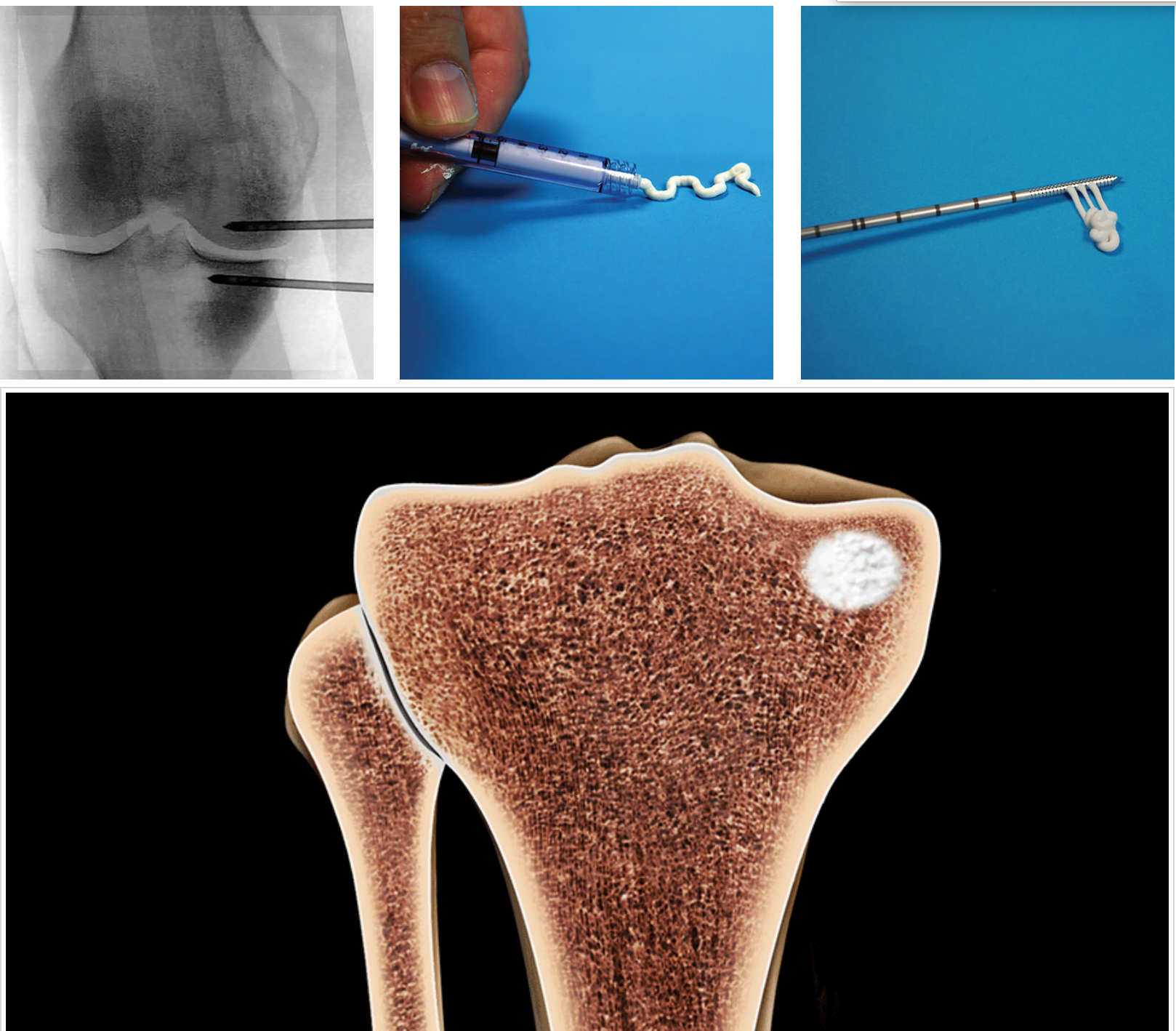What is SCP (The Subchondroplasty Procedure)?
What is SCP?®
“As the bones see more stress, not infrequently we start seeing what are called “insufficiency fractures” sometimes even called bone bruises.”
Subchondroplasty: An Introduction
Often times, as people are developing the wear and tear type of arthritis in their knee, the tibia, or leg bone, starts seeing a lot more stress. This comes from the “bone on bone” changes that are occurring.
As the bones see more stress, not infrequently we start seeing what are called “insufficiency fractures” sometimes even called bone bruises.
There seems to be more and more evidence that a lot of the pain from the arthritis comes, not from the bone on bone changes, but from the developing insufficiency fracture.
SCP - A New Procedure
For the past year, or even two, when we see these bony changes on MRI, we perform a procedure, by injecting a bone graft substitute into the bone to seal up the insufficiency problem. This is called a subchondroplasty.
Think of it as injecting a type of grout into the middle of the bone to help support it while it attempts to heal.
SCP - Early But Promising Results
The results are early, but they seem quite promising in these patients. You may be the right patient for this procedure if your pain seems greater than you would think from the amount of arthritis present, or the tenderness is actually on the bone rather than in the joint.
Please scroll down to read more about the SCP Procedure
Dr. Sterett
More on the procedure from Subcondroplastey.com:
“The Subchondroplasty® (SCP ®) Procedure is a fluoroscopic, minimally-invasive procedure that targets and fills subchondral bone defects with a hard-setting bone substitute material that is replaced with new bone during the healing process.”
SCP is a minimally-invasive, fluoroscopically-assisted procedure that targets and fills subchondral bone defects through the delivery of AccuFill® Bone Substitute Material (BSM), a nanocrystalline, highly porous injectable calcium phosphate (CaP).
The SCP® Procedure is usually performed along with arthroscopy for visualization and treatment of findings inside the joint. In some cases, an open or mini-open procedure is necessary for access to the defect.
Your surgeon will base a diagnosis of a subchondral bone defect on your clinical history, physical exam and MRI findings.
A subchondral bone defect, often referred to as a Bone Marrow Lesion, or BML, is a term for a finding on an MRI that represents an abnormal area or defect inside the bone.
What is a Bone Marrow Lesion (BML)?
Bone marrow lesions (sometimes called Bone Marrow Edema) are small defects typically found in subchondral bone, the region below the cortical bone near a joint. They can only be seen on certain MRI sequences, appearing as a hazy white area against the background of darker bone.
Pathologists have shown that BML represent a healing response surrounding small defects in the subchondral bone, such as micro trabecular fractures.1
What Causes a BML?
In some cases, BML defects are a result of a bone injury that doesn't heal properly. In other cases, BML may be a stress reaction that forms from overuse or poor joint mechanics. Other factors that correlate to chronic BML include:
- Obesity and poor diet are thought to increase the likelihood of developing BML
- BML are more commonly found in middle-aged patients than in younger patients
- Patients with poor joint alignment are more likely to develop BML
- Adults who quickly increase activity may develop BML
How Do I Know If the SCP® Procedure Is Right for Me?
Patients typically present with:
- Presence of bone defect seen on fat-suppressed MRI (T2FS, PDFS, STIR, etc.)
- No resolution of BML with conservative care or other intervention
Discuss all treatment options with your patient. All surgical procedures carry a certain level of risk. A complete assessment of possible risks should be discussed before making the decision to have surgery.
You may have a defect in the bone adjacent to your joint called a chronic Bone Marrow Lesion (BML). Many surgeons believe that chronic BML will not heal without intervention.
BML can only be seen on MRI. Only your doctor can tell you if you have this condition.
Discuss treatment options and potential risks with your surgeon. It is important that you fully understand all risks and benefits before making a decision to have surgery. Only your doctor can tell you if The Subchondroplasty® Procedure may be right for you.
Surgical Procedure Overview
“AccuFill® Injectable Bone Substitute Material is an injectable, self-setting, macroporous, osteoconductive, calcium phosphate bone graft substitute material that is intended for use to fill bony voids or gaps of the skeletal system of the extremities, spine (i.e. posterolateral spine), and pelvis that are not intrinsic to the stability of the bony structure. These defects may be surgically created osseous defects or osseous defects created from traumatic injury to the bone. AccuFill® Injectable Bone Substitute Material is a bone graft substitute that resorbs and is replaced with new bone during the healing process.”
The SCP® Procedure is a minimally-invasive surgery that targets and fills chronic subchondral defects sometimes referred to as BML.
During the procedure, your surgeon will use fluoroscopy (intraoperative X-ray) to place a small, drillable cannula in the area of the bone defect. Your surgeon will then deliver AccuFill® Bone Substitute Material (BSM) into the defect, where it hardens with properties that mimic cancellous bone. During the healing process, the AccuFill® BSM is resorbed and is replaced with new bone.
What is AccuFill® BSM?
AccuFill® BSM is an engineered calcium phosphate mineral compound. It flows readily to fill the subchondral defect and hardens quickly into a biomimetic implant once injected. AccuFill® BSM mimics the properties of cancellous bone and is replaced with new bone during the healing process.
What Can I Expect After Surgery?
Patients are typically treated in an outpatient setting, returning home the same day of the procedure. Postoperatively, your doctor will recommend a short recovery course, similar to that of arthroscopy.
It’s important to note that recovery from The SCP® Procedure is different for every patient. However, the following is common for most patients:
- For the first 48–72 hours after The SCP® Procedure, patients will often experience significant pain in the operative area. Your doctor will likely prescribe pain medication to treat these symptoms. Follow your doctor’s advice closely.
- For the initial period, most doctors will recommend walking and standing with crutch support. The use of crutches is typically reduced as tolerated.
- Your doctor will also recommend a course of physical therapy and activities to help you regain strength and maintain mobility of your joint.
It is important to follow your doctor’s advice as you recover.
How do I get started?
The first step is to speak to a surgeon trained to perform The Subchondroplasty® Procedure (find a surgeon in your area).
Will I be anesthetized during the procedure?
Anesthesia is a way to control pain during a procedure. Some surgeons use a local and/or regional anesthetic that numbs the operative area, which allows you to remain awake but pain-free during surgery. Other surgeons prefer general anesthesia. With general anesthesia, you will be unconscious and not feel pain during the procedure.
What are the precautions and risks for this treatment?
Only your health care team can determine if you are healthy enough for surgery. Consult your doctor for a complete assessment of possible risks before deciding to have surgery. Review the instructions for use for more information about precautions and risk.
If you and your doctor determine that total joint replacement is necessary, a prior Subchondroplasty®Procedure does not prevent this as an option. Should it become necessary, total joint replacement is still an option for you.
Are there alternatives to SCP® Surgery?
A course of conservative treatment—to include pain medications, joint braces, crutches, physical therapy and/or injections into the joint—may allow the body to heal bone defects sometimes referred to as BML, and is usually recommended before proceeding with any surgical procedure.
If the bone does not heal with conservative care your surgeon may recommend surgery.
Please visit subchdroplasty.com for more information, and feel free to contact Dr. Sterett for more information: SterettTeam@vsortho.com















